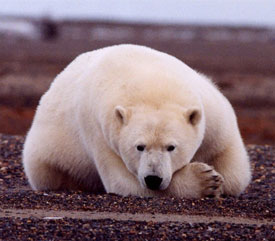Polar bear may be listed as endangered species
Rhett A. Butler, mongabay.com
February 9, 2006
The U.S. Fish and Wildlife Service today announced that it is considering a petition to list the polar bear (Ursus maritimus) as threatened under the Endangered Species Act. Scientists believe polar bear populations are increasingly in danger due to the effects of climate change, specifically receding ice and warming temperatures.
Drowned polar bears are being found for the first time by researchers in Alaska, who speculate that greater distances between ice sheets could be taking a toll on the bears. While bears are capable of swimming long distances—up to 60 miles (100 km) without stopping—it is conceivable that they could suffer from exhaustion during an unexpectedly arduous swim.
The loss of ice also makes it more difficult for bears to find food. Unlike grizzly bears, polar bears aren’t adapted to hunting land animals like caribou, instead feeding primarily on seals. However, recent aerial surveys by the U.S. Fish and Wildlife Service show that, over the past five years, polar bears are changing their habits and spending more time on land, congregating on beaches and scavenging whale carcasses.
Extrapolating from these developments, some scientists believe that polar bears could be extinct in the wild within the next century. While the last survey in 1997 suggested that polar bears in Alaska were not endangered, next year’s update might come to a different conclusion. Scientists estimate there are currently 20,000 to 25,000 polar bears world-wide.
 Courtesy of the U.S. Fish and Wildlife Service |
The U.S. Fish and Wildlife Service—the principal Federal agency responsible for conserving, protecting and enhancing fish, wildlife and plants and their habitats in the United States—will review the status of the bear bear over the next 12-month to determine whether it warrants listing. In coming to their conclusion, the agency will examine information on population distribution, density and trends, taxonomy, food habits and habitat selection; information on the short and long-term effects of climate change and sea ice change on the distribution and abundance of polar bears and their principal prey; information on the effects of other potential threats to the species, including oil and gas development, contaminants, hunting and poaching, and; information concerning whether any populations of the species may qualify as distinct population segments.
The U.S. Fish and Wildlife Service manages the 95-million-acre National Wildlife Refuge System, which encompasses 544 national wildlife refuges, thousands of small wetlands and other special management areas.
Related
Polar bears hold key to understanding health risk of environmental pollutants
Polar bears and people, at the chilly top of the Arctic’s food chain, risk consuming a smorgasbord of industrial pollutants that have seeped into their habitat and pose potential health hazards. Now a University of Florida researcher, aiming to better understand just how dangerous the chemicals might be to humans, has zeroed in on how effectively polar bears are able to rid themselves of environmental toxins consumed in the food they eat. It turns out the bears can completely eliminate only one of five of the classes of industrial contaminants they are exposed to, a finding that’s bad news for the bears and other species who share their environment.
This article used information from previous mongabay.com articles, The Wall Street Journal, and press materials from the the U.S. Fish and Wildlife Service.